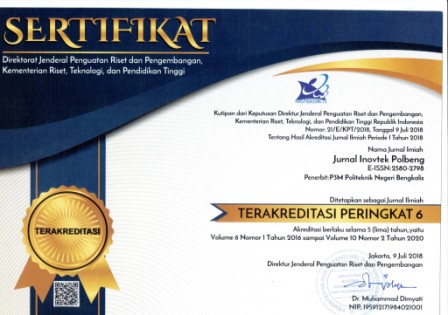Characteristics of Silica Sand Shipyard Sandblasting Waste as Construction Materials
Abstract
Keywords
Full Text:
PDFReferences
Pemerintah Indonesia, Peraturan Pemerintah No. 101 Tahun 2014 tentang Pengelolaan Limbah Bahan Berbahaya dan Beracun, Peraturan Pemerintah, Jakarta, 2014.
G. K. Attri, R. C. Gupta, and S. Shrivastava, “Sustainable precast concrete blocks incorporating recycled concrete aggregate, stone crusher, and silica dust,†J Clean Prod, vol. 362, Aug. 2022.
S. Ramdani, A. Guettala, M. L. Benmalek, and J. B. Aguiar, “Physical and mechanical performance of concrete made with waste rubber aggregate, glass powder and silica sand powder,†Journal of Building Engineering, vol. 21, pp. 302–311, 2019.
H. Binici and O. Aksogan, “Durability of concrete made with natural granular granite, silica sand and powders of waste marble and basalt as fine aggregate,†Journal of Building Engineering, vol. 19, pp. 109–121, 2018.
S. G. M. and J. P., “Assessment of usage of manufactured sand and recycled aggregate as sustainable concrete: A review,†Mater Today Proc, vol. 64, pp. 1029–1034, 2022.
S. He, C. Jiao, Y. Niu, and S. Li, “Utilizing of coral/sea sand as aggregates in environment-friendly marine mortar: Physical properties, carbonation resistance and microstructure,†Case Studies in Construction Materials, vol. 16, p. e00981, 2022.
Sunita, “Effect of biomass Ash, foundry sand and recycled concrete aggregate over the strength aspects of the concrete,†Mater Today Proc, vol. 50, pp. 2044–2051, 2022.
A. Gholampour, J. Zheng, and T. Ozbakkaloglu, “Development of waste-based concretes containing foundry sand, recycled fine aggregate, ground granulated blast furnace slag and fly ash,†Constr Build Mater, vol. 267, p. 121004, 2021.
M. A. de Barros Martins, R. M. Barros, G. Silva, and I. F. S. dos Santos, “Study on waste foundry exhaust sand, WFES, as a partial substitute of fine aggregates in conventional concrete,†Sustain Cities Soc, vol. 45, pp. 187–196, 2019.
R. Dharmaraj, S. Maruthivenkatesh, K. Narayanan, M. Ramalingam, Y. Aarthi, and P. Rajalinggam, “Resilience and sturdiness of the foundry sand as a result of the partial substitution of cement and fine aggregate,†Mater Today Proc, 2022.
L.-Y. Xu, B.-T. Huang, J.-C. Lao, and J.-G. Dai, “Tailoring strain-hardening behavior of high-strength Engineered Cementitious Composites (ECC) using hybrid silica sand and artificial geopolymer aggregates,†Mater Des, vol. 220, p. 110876, 2022.
R. Malathy et al., “Use of Industrial Silica Sand as a Fine Aggregate in Concrete—An Explorative Study,†Buildings, vol. 12, no. 8, Aug. 2022.
S. K. Sharma and H. Gupta, “Development of Paver Block by Using Foundry Sand Based Geopolymer Concrete,†Journal of Today’s Ideas - Tomorrow’s Technologies, vol. 3, no. 2, pp. 129–144, Dec. 2015.
Y. E. Putra dan Sutikno, Pemanfaatan Limbah Sandblasting sebagai Bahan Campuran Paving Block. Jurnal Rekayasa Teknik Sipil. 01(01): 81-86, 2016.
P. R. de Matos, M. F. Marcon, R. A. Schankoski, and L. R. Prudêncio Jr., “Novel applications of waste foundry sand in conventional and dry-mix concretes,†J Environ Manage, vol. 244, pp. 294–303, 2019.
S. Kulkarni and V. Katti, “Article ID: IJCIET_08_09_058 Pavers,†International Journal of Civil Engineering and Technology (IJCIET), vol. 8, no. 9, pp. 498–505, 2017.
G. Yogha Luthfizar, F. Sri PujiP, and T. Akbari, “Pemanfaatan Limbah Pasir Silika sebagai Bahan Pengganti Pasir untuk Pembuatan Paving Block,†2019.
K. Jitendra and V. C. Khed, “Optimization of concrete blocks with high volume fly ash and foundry sand,†Mater Today Proc, vol. 27, pp. 1172–1179, 2020.
K. D. Wulandari and J. J. Ekaputri, “An Investigation of Damage Factors in Industrial Scale of Light-Weight Bricks Production,†in MATEC Web of Conferences, Dec. 2017, vol. 138.
J. C. Santamarina, “Soil behaviour: The role of particle shape,†2004.
P. Manurung and P. Karo-Karo, “Analisis dan Karakterisasi Kandungan Silika (SiO2 ) sebagai Hasil Ekstraksi Batu Apung (Pumice),†2017.
DOI: https://doi.org/10.35314/ip.v12i2.2865
Refbacks
- There are currently no refbacks.
Copyright (c) 2022 INOVTEK POLBENG
This Journal has been listed and indexed in :

inovtek polbeng by http://ejournal.polbeng.ac.id/index.php/IP is licensed under a Creative Commons Attribution-ShareAlike 4.0 International License









